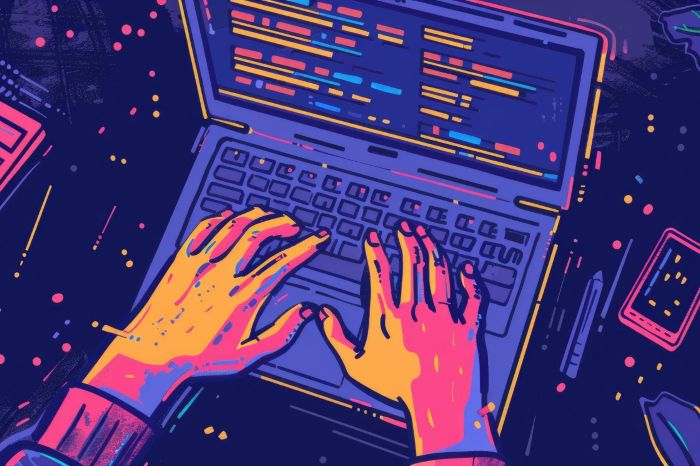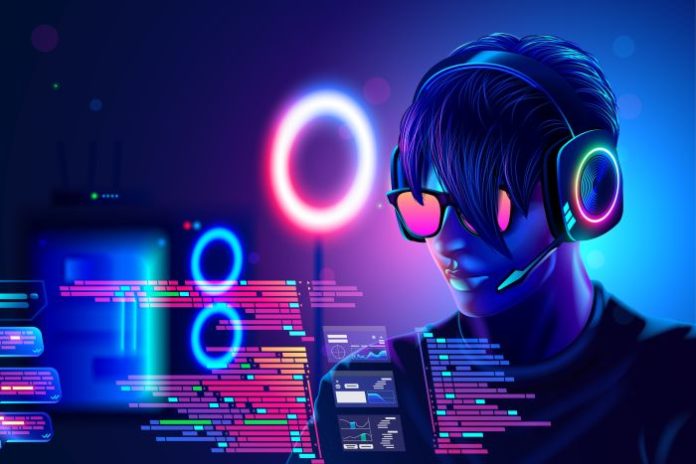What is Vibe Coding? (Simple Definition)
Vibe coding is the developing system of building software through natural language, creativity, and rapid iteration. Instead of writing traditional code line-by-line, being careful of syntax, developers (and non-developers) describe their vibe. For a vibe coding example, a coder might like “a cozy, minimalist budgeting app” or “a bold, neon sci-fi dashboard.” An AI coding tool then builds the foundation from your vibe coding prompts.
Thanks to TikTok developers posting their quick, AI-assisted build sessions, the term, “vibe coding,” spread on social media. The idea really took off when AI teachers like Andrew Ng started talking about it as a natural next step in prompt-driven programming. When he highlighted “vibe coding” as an indication that AI transforms how we build software, the phrase took shape.
Vibe coding is about intent, not about how it appears. You describe what you want the software to feel like, and then you quickly make changes until it matches your vision.
Key Takeaways
- Vibe coding allows developers to create software by describing the desired ‘vibe’ rather than writing traditional code.
- This approach gained popularity in 2025 due to powerful AI tools, viral short-form videos, and lowered barriers to entry.
- To start vibe coding examples, choose an AI coding tool and describe the vibe you want, focusing on feelings rather than syntax.
- Developers can refine their projects through iterative feedback, continuously improving until the result matches their vision.
- While vibe coding is accessible and playful, it won’t replace traditional coding roles in areas requiring high security or complex integration.
Table of contents
- What is Vibe Coding? (Simple Definition)
- Why Vibe Coding Became So Popular in 2025
- How to Start Vibe Coding Examples (Even If You’re Not a Programmer)
- Vibe Coding Examples for Beginners to Experts
- 10 Vibe Coding Examples That You Can Copy and Paste
- Best AI Vibe Coding Tools in 2025 (Ranked)
- Is Vibe Coding the Future of Programming?
- Vibe Coding Security Vulnerabilities You Should Know
- Final Thoughts
Why Vibe Coding Became So Popular in 2025
There were three key reasons why vibe coding took off:
1. AI Tools Have the Power to Build Whole Applications
Cursor, Bolt, Lovable, Replit Agents, and Claude Artifacts are some of the platforms that can generate multi-file projects, UI components, database layers, and API calls with surprising accuracy.
2. Coding Became “Watchable” With Short-Form Video
Developers began filming quick-build sessions of vibe coding examples. For instance, “Here’s me coding a to-do app in 11 minutes.” These videos went viral, and the phrase took off.
3. It Removes Barriers to Getting Started
People intimidated by code suddenly understood that they could build real apps just by describing the experience they desire. By leveling the playing field, vibe coding increased in popularity very quickly.
How to Start Vibe Coding Examples (Even If You’re Not a Programmer)
Step 1: Choose an AI Coding Tool
These tools are all great for vibe coding workflows:
- Cursor: Great for full-stack iteration
- Bolt.new: Great for quickly spinning up deployable apps
- Lovable: Great for making beautiful UIs
- Claude Artifacts: Best for structured, modular builds
- Replit Agents: Best for beginners
- GitHub Copilot: Traditional but still useful
Choose the one that matches your comfort level. Cursor and Bolt are most popular with vibe coders.
Step 2: Describe The Vibe, Not the Code
Old prompt: “Use Tailwind and React to make a dashboard.”
Vibe coding prompt: “Create a clean, soft, pastel dashboard with rounded corners that gives off a calming wellness vibe. Keep the text short and the layout symmetrical.”
You tell the AI how it should feel, not just what it should do.
Step 3: Go Through the Process Again, Both Visually and Verbally
This is the philosophy of vibe coding examples. You look at the AI output and tell it to:
- “Make it more fun.”
- “Give it a high-end and luxurious feeling.”
- “Increase they whitespace and reduce contrast.”
- “Make the animations softer.”
The AI regenerates instantly.
Step 4: Test and improve
Once the vibe matches your vision, continue making adjustments:
- Fix the logic
- Make it more responsive
- Add authentication
- Connect APIs
Vibe coding gives you the basics. Refinement gets it ready for production.

Vibe Coding Examples for Beginners to Experts
These are the real workflows that people use when they vibe code today.
Example 1 — A “Daily Vibe Tracker” App
Prompt: “Make a simple web app that tracks your mood and has a warm, comforting look.” Use icons that look like they were written by hand, soft gradients, and rounded buttons.”
What the AI generates:
- Form for entering mood
- Dashboard with entries that are color-coded
- Soft UI components
- Animation that happens when you hover over it
Try vibe coding examples again with prompts like:
- “Make it cozier.”
- “Add some subtle depth to the shadow.”
- “Make it less saturated to make it feel calmer.”
Example 2: A Cute Dashboard for Productivity
Prompt: “Make a fun productivity dashboard with pastel colors, round shapes, and a silly look. Add a progress meter, timers, and to-do lists.”
Typical output: A React or Next.js dashboard with stylized UI element.
You can ask for these vibe coding prompts improvements:
- “Make whimsy 20% more.”
- “Use a cartoonish font for the headings.”
- “Make the buttons a little more puffy.”
Example 3: Aesthetic CSS Themes (Cottagecore, Vaporwave, Minimalist)
Cottagecore Prompt: “Make a CSS theme with soft floral colors, serif fonts, and a vintage country feel.”
Vaporwave Prompt: “Create a neon, retro-digital theme with purples, blues, glitch accents, and large font.”
Minimalist Prompt: “Make a UI that is very clean, black and white, has a simple layout, a lot of white space, and thin text.”
These prompts based on vibes are what make AI coding tools feel creatively liberating.
10 Vibe Coding Examples That You Can Copy and Paste
You can use these to make full apps, landing pages, or prototypes.
- “Make a journal app that feels warm and cozy with soft textures and smooth animations.”
- “Make a modern, sleek dashboard with glassmorphism and neon accents.”
- “Create a budgeting app that is bubbly and fun, with round shapes and pastel gradients.”
- “Make a calm, elegant business landing page that looks professional.”
- “Make a simple portfolio site with a lot of empty space and subtle movement.”
- “Make a moody, movie-like UI with dark colors and glowing highlights.”
- “Make a wellness tracker that is calming and has soft icons and a spa-like feel.”
- “Create a strong SaaS homepage with high contrast and strong fonts.”
- “Make a recipe app that feels like home with warm colors and handwritten fonts.”
- “Make a landing page that looks like it came from the year 2000, with shiny buttons and things that remind you of the past.”
These rank well for “vibe coding prompts” and “vibe coding examples.”
Best AI Vibe Coding Tools in 2025 (Ranked)
1. Cursor – Best Overall
- Builds complete apps
- Understands complex instructions
- Excellent for iteration
2. Bolt.new – Best for Speed
- Deployable apps in minutes
- Great UI defaults
- Perfect for hackathons
3. Lovable – Best Aesthetics
- Incredible UI theme generation
- Aesthetic-forward layouts
- Low KD keyword tie-in
4. Claude (Artifacts) – Best Structure
- Highly organized code
- Strong reasoning
- Great for maintaining cleanliness
5. Replit Agents – Best for Beginners
- Simplest learning curve with vibe coding examples
- Fast onboarding
- Huge community
6. GitHub Copilot – Stable Classic
- Excellent autocomplete
- Great for refinement
- Works well with vibe-coded foundations
Is Vibe Coding the Future of Programming?
Vibe coding lowers the barrier to entry. It makes software feel accessible, playful, and fast. But it’s not replacing developers—it’s changing where developers spend their time.
What Vibe Coding Is the Future Of:
- Making prototypes quickly
- Exploring design
- Building MVPs quickly
- Improving UI aesthetics
- Teaching beginners with vibe coding examples
What It’s Not Replacing Anytime Soon:
- Systems engineering for production backends
- Apps that need to be secure
- Complex integrations
- Performance optimization
It’s a tool, not a replacement for engineering skill.
Vibe Coding Security Vulnerabilities You Should Know
The vibe coding trend does have drawbacks:
- AI hallucinations make logic less certain. It’s common to have missing validation, unsafe endpoints, and shallow authentication.
- Over-reliance on generated dependencies. AI tools might pull packages that are old or dangerous.
- Auto-generated code has hidden security holes. Developers might not know the logic well enough to find problems.
How to lower your risk:
- Use automated security scanners
- Use dependency audits
- Add rate limiting and input validation
- Never deploy AI-generated code without review
- Treat vibe-coded apps as prototypes first
Final Thoughts
Vibe coding is not just a meme; it’s a fun, quick, and easy way to make software using natural language and AI feedback that gets better over time. You can make surprisingly polished apps with Cursor, Bolt, Lovable, Claude, or Replit just by saying what kind of vibe you want.
Experiential learning and practice with vibe coding examples are the best ways to improve. Begin with easy tasks, use some of the suggestions above, and don’t be afraid to keep changing things until the interface feels right.











